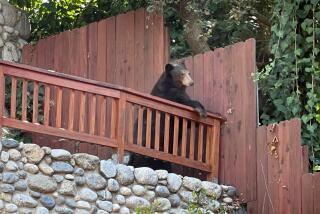Paranoia Is Bruin After Bears Kill 2 : Wildlife: Experts in Alaska call the fear ‘bearanoia.’ Many residents arm themselves.
- Share via
EAGLE RIVER, Alaska — Experts call it “bearanoia.”
It is the acute fear of bears, such as that which gripped one wide-eyed tourist who quizzed Ranger Marcie Moore about the dangers of Moose Creek, a tiny town that was his next destination.
“He said, ‘I don’t want to go where there are any bears,’ ” said Moore, who is stationed at the Chugach State Park Visitor Center here. “I hated to tell him, but there are bears all over.”
Bearanoia is running thick in Alaska, where two people have been killed and partially eaten in separate attacks this month.
Vacationer Darcy Staver, 33, of Ft. Lewis, Wash., was killed July 8 by a 150-pound black bear that stalked her and broke into her cabin near Glennallen, a town about 150 miles northeast of Anchorage.
Two days later, a 6-year-old boy named Antone Bear was killed by a young brown bear that snatched the boy as he was walking with his mother on a road in King Cove, a village about 600 miles southwest of Anchorage.
The attacks were a conversation topic at the park visitor center, which is surrounded by towering peaks, hanging glaciers and the abundant wildlife that is Alaska’s pride and main tourist attraction.
“My only thought was, ‘Where were these people’s minds?’ I can’t believe they were out there unarmed,” Lank Snow of Eagle River said.
Mike McDonald, a bear specialist with the Alaska Department of Fish and Game, said the attacks were coincidental.
“You can equate it to having two 747 jetliners crash within two days of each other,” he said. “These are real extraordinary things that happen, but they do happen.”
Only 24 people have been killed in Alaska by bears since 1900, McDonald said. More people are killed in the state by dogs.
Fielding a flood of calls and queries, he and other experts have been repeating their longstanding bear advice:
Human visitors to bear country should make noise to avoid surprising the animals, they said. When a bear notices you, the best strategy is to stand your ground and talk in an even tone. To run--as Antone Bear did--stimulates the animals’ predatory instincts, and bears can easily outrun humans.
Alaskans appear unwilling to take chances. Anchorage sports stores were cleaned out last weekend of their supplies of “Counter Assault,” a pepper-based bear-deterrent spray that goes for $40 a can.
“Everybody I waited on bought a can or two,” said Lynn Gerbig, a clerk at Gary King Sporting Goods. The only spray left on the shelves, she said, was a mugger repellent too weak to faze bruins. “It’s for humans. That wouldn’t do anything to bears,” she said dismissively.
McDonald and Moore said they fear a more harsh reaction.
“If people go out and just start shooting at any bear they see, that can be a problem, because they’re not easy animals to kill. If you wound one, then you’ve tripled your trouble right there,” McDonald said.
“I think there’s a possibility of bears being shot at because of bearanoia,” Moore said.
Possibly more dangerous are the piles of unattended garbage that are wildlife managers’ bane and have multiplied in Alaska, a state with the nation’s second-highest population growth rate.
Garbage bears, which dine on human trash and learn to associate people with food, often become aggressive and dangerous, McDonald said. Fifteen garbage bears had to be shot last summer in Juneau alone, he said, and Darcy Staver’s killer appeared to be a garbage bear.
Raw bearanoia, the biologist acknowledged, sometimes irritates him.
More to Read
Sign up for Essential California
The most important California stories and recommendations in your inbox every morning.
You may occasionally receive promotional content from the Los Angeles Times.













